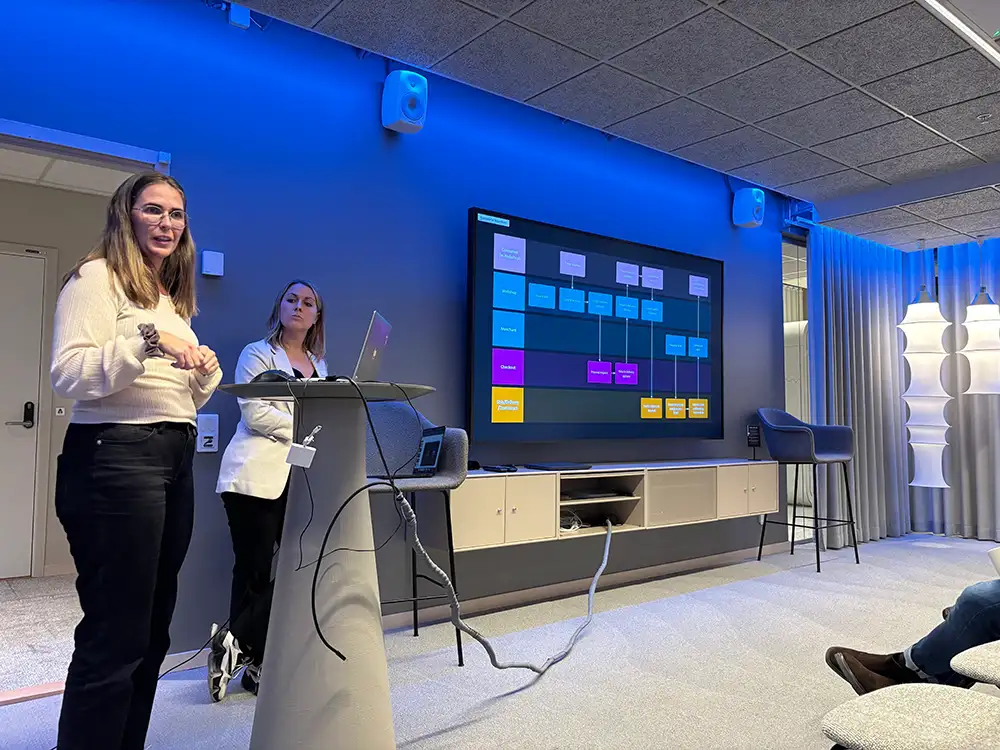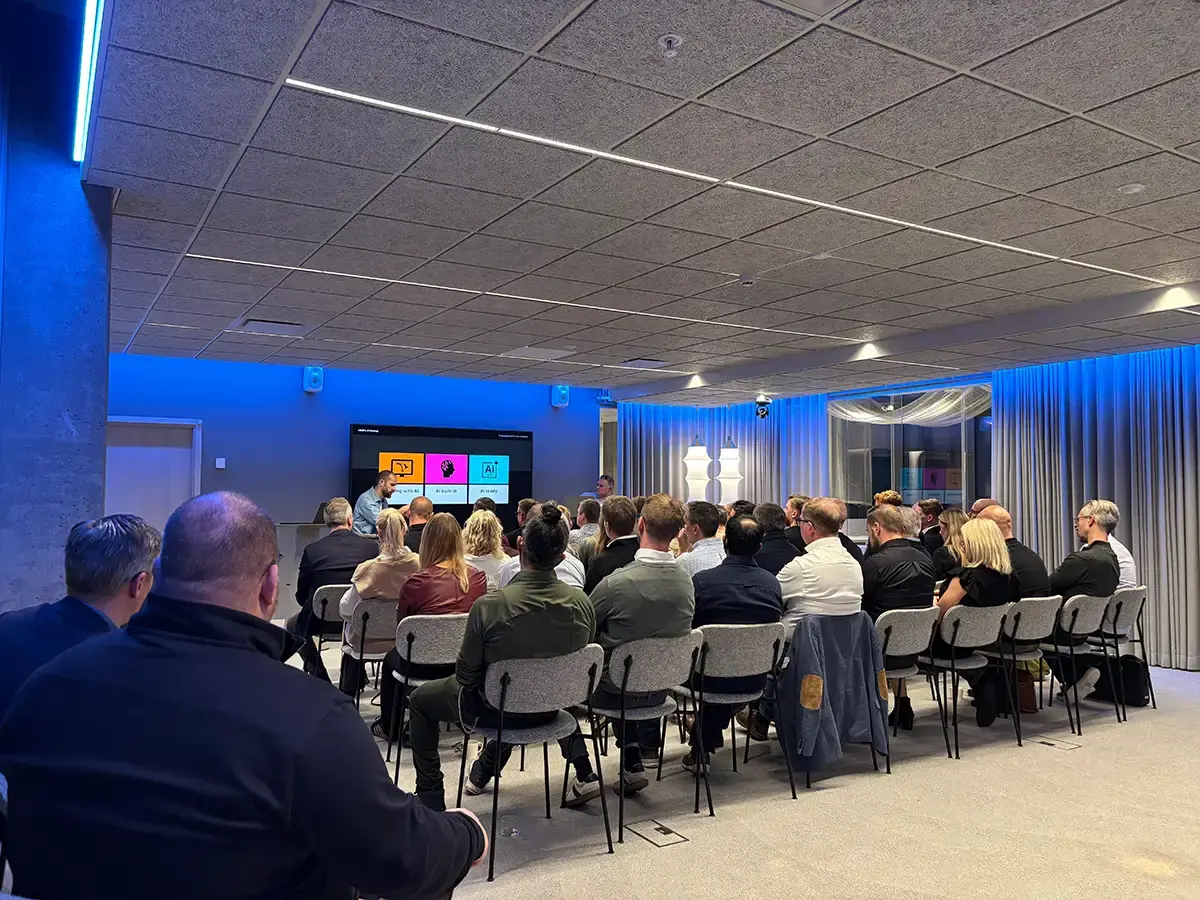
Last update: 30.06.2025
In this blog:
- It starts with a simple question: “Where is my order?”
- Why AI agents are gaining ground
- The hidden challenge... and the solution
- Ecommerce: Automate branded post-purchase journeys
- Customer service: Cut WISMO tickets in half with AI-ready tracking data
- Operations & Logistics: Reduce delivery failures and improve carrier SLA performance
- IT & Data: Power all customer systems with one standardized tracking feed
- Real-world example
- Want to spend less time chasing deliveries…and more time growing your business?
- Further reading: Parcel tracking FAQs
It starts with a simple question: “Where is my order?”
A shopper just placed a high-value order for a limited-edition sneaker drop. They’re excited, watching their inbox. Days pass, but the updates are vague: “in transit,” “delayed,” no clear explanation. Frustrated, they call support. The agent fumbles between carrier portals, trying to decode what “Exception Code 902” means. The shopper leaves a one-star review and abandons their next cart.
Sound familiar?
Now imagine that same customer gets an instant message:
“Your order was delayed due to local flooding. It’s now expected on Thursday between 2–4 PM. Let us know if you’d like to reschedule.”
Calm. Clear. Human. That’s what great delivery experiences look like. They start with data. Structured, standardized, usable data.
That’s why some of the world’s most loved brands are turning to AI-powered customer care to scale support without sacrificing service. AI-driven automation can reduce customer service costs by up to 30%, while a single chatbot can handle multiple simultaneous interactions, scaling support efficiently without sacrificing quality.
Why AI agents are gaining ground
Rising customer expectations are straining traditional support teams. Simple but frequent questions (“Where is my order?”, “Can I update the delivery address?”, “Has my return been received?”) consume time and resources.
AI-powered virtual agents offer a scalable solution. They provide around-the-clock responses and free up human agents to focus on complex or sensitive issues. Done right, AI-driven support leads to faster resolutions, lower costs, and better customer experiences.
But there’s a catch: these AI agents are only as effective as the data they rely on. Without clean, standardized and consistent tracking data, even the smartest bots don’t work.
The hidden challenge... and the solution
Here’s the problem: delivery carrier companies speak different languages. One might call a delay an “Exception.” Another might say “Late Delivery.” Some might not notify you at all.
Without a unified standard, AI struggles to surface accurate information or manage customer expectations. On the other hand, gathering and reconciling this data manually from dozens of carrier systems, APIs, and formats is a massive undertaking. It would require weeks of development work, ongoing maintenance, and constant translation logic across systems. For most businesses, this is resource-heavy and unsustainable.
As our subject matter experts are emphasizing, nShift has solved this delivery challenge by converting fragmented carrier data into a standardized data feed of 50+ standardized tracking events, grouped into categories like:
- System events (e.g., “Label created”)
- In-transit updates (e.g., “Out for delivery”)
- Delivered events (e.g., “Delivered to receiver”)
- Exceptions (e.g., “Delivery attempt failed”)
With structured tracking data in place, AI agents can:
- Instantly surface accurate delivery status
- Automatically send notifications such as "Your delivery has been delayed due to weather. A new delivery window will be shared shortly."
- Explain delays in customer-friendly language
- Tailor the customer experience to individual preferences (e.g., "Since you typically choose weekend deliveries, would you like to reschedule for Saturday?")
- Seamlessly escalate complex cases to human agents, with full delivery context
Businesses who implement standardized tracking get significant reductions in WISMO tickets, often by as much as 50%. Customers stay informed, anxiety fades, and what could be a negative experience becomes a loyalty-building event.
With the foundational concepts of structured tracking data now in place, let’s explore how it creates value across key functions.
Ecommerce:
Automate branded post-purchase journeys
Today’s ecommerce leader is expected to manage more than just a seamless checkout. They are stewards of the full customer experience.
With standardized tracking, they can keep customers informed, connected, and confident after checkout. It builds loyalty without adding complexity behind the scenes.
When tracking data flows cleanly into ecommerce and CRM platforms, it is easier to keep customers in the loop and bring them back for more. Brands can trigger smart delivery updates, send the right offers at the right moment, and fix issues before they become lost sales. That’s how a good first impression turns into lasting loyalty.
Customer service:
Cut WISMO tickets in half with AI-ready tracking data
Customer service teams feel the pressure when delivery experiences fall short.
With nShift, tracking data from all carriers is consolidated into a consistent format. AI-powered chatbots, armed with a single, normalized tracking feed, can instantly resolve up to half of all delivery-related inquiries. Meanwhile, human agents are freed up to focus on nuanced, high-empathy cases that truly require a personal touch.
The result? Lower ticket volumes, higher CSAT scores, and smarter use of your team's expertise.
Operations & Logistics:
Reduce delivery failures and improve carrier SLA performance
Carrier data is fragmented, with each carrier using different terminology and tracking standards, resulting in logistics teams operating blindfolded.
For them, standardized tracking shines a spotlight on problems early. It flags stalled deliveries, missed scans, and failed drop-offs before they turn into customer complaints. It powers SLA tracking and carrier scorecards. It also gives warehouse and delivery teams the data they need to plan smarter and act faster.
That’s why retailers using standardized data often report significant improvements in carrier accountability and measurable reductions in logistical friction.
IT & Data:
Power all customer systems with one standardized tracking feed
Behind every seamless delivery experience sits a reliable data infrastructure and a unified tech stack. But for IT leaders, managing the flow of tracking data across OMS, CRM, ERP, and AI tools is a growing challenge, especially when that data is inconsistent or incomplete.
With one clean delivery feed, IT teams can connect every system — from CRM to ERP — without constant patchwork fixes. They can also push clean, actionable delivery events across internal systems, and deploy customer-facing AI more quickly and confidently. It is faster to deploy, easier to scale, and smarter for future growth.
nShift integrates with AI-ready platforms like Zendesk or Freshdesk, which offer delivery-focused chatbot templates. That means faster time-to-value and cleaner data across the stack.
It’s a foundation for scalable growth, not another integration project waiting to happen.

Real-world example
One global sportswear retailer is already doing this at scale. They integrate nShift’s standardized tracking data directly into their AI-powered customer support tool. This integration seamlessly connects their ecommerce platform, OMS, ERP, and CRM systems, enabling automated customer communications with minimal human intervention. Because the delivery statuses are standardized across carriers, their customer support, marketing, and IT systems all speak the same language.
As a result, the brand has reduced customer support inquiries significantly, improved their SLA tracking, and enhanced customer satisfaction scores.
Want to spend less time chasing deliveries...
…and more time growing your business?
Standardized tracking isn’t just about knowing when a parcel arrives. It is about giving every team in your business the data they need to create consistent, proactive, personalized experiences. If your ecommerce, operations, customer service, and IT teams are each working with fragmented carrier data, you’re wasting time and delivering a disconnected experience.
Let’s fix that. Book a tailored consultation to find out how the nShift platform can help you turn your delivery operations into a revenue machine.
Turn tracking into engagement, not support tickets
nShift Track replaces “Where is my order?” with proactive, branded, multi-channel updates that reassure customers and outperform traditional marketing emails by up to 5x.
Learn moreFurther reading: Parcel tracking FAQs
What is WISMO?
WISMO stands for "Where Is My Order," a common term in delivery management representing customer inquiries about their order status. It reflects the growing need for transparent communication and real-time updates during the shipping process. Addressing WISMO effectively helps businesses enhance customer satisfaction and reduce support workloads. Timely and accurate responses to WISMO inquiries can also foster trust and loyalty among customers.
What is last mile tracking?
Last mile tracking is the process of monitoring a package's final stage of delivery, from the local distribution hub to its destination. It provides customers with real-time updates on delivery progress, ensuring greater transparency and predictability. This tracking capability minimizes uncertainty and enhances the overall customer experience. Businesses benefit by proactively addressing delays and improving operational efficiency for final-mile logistics.
What is a parcel tracking notice?
A parcel tracking notice is a notification that provides key details about a shipment's status, location, and estimated delivery time. It typically includes a tracking number and a link to monitor the package in real time. These notices keep customers informed, reducing the need for delivery-related inquiries. Clear and consistent tracking notices promote transparency and build customer trust in the delivery process.

Author
Luc Altorf
Industry Expert, nShift
Luc Altorf is a dynamic professional focused on forging strategic partnerships and driving new ventures in the ecommerce and parcel logistics sectors. With a results-driven approach, Luc works closely with customers and partners to uncover opportunities that enhance growth and efficiency.

About the author
Luc Altorf
Industry Expert, nShift
Luc Altorf is a dynamic professional focused on forging strategic partnerships and driving new ventures in the ecommerce and parcel logistics sectors. With a results-driven approach, Luc works closely with customers and partners to uncover opportunities that enhance growth and efficiency.






